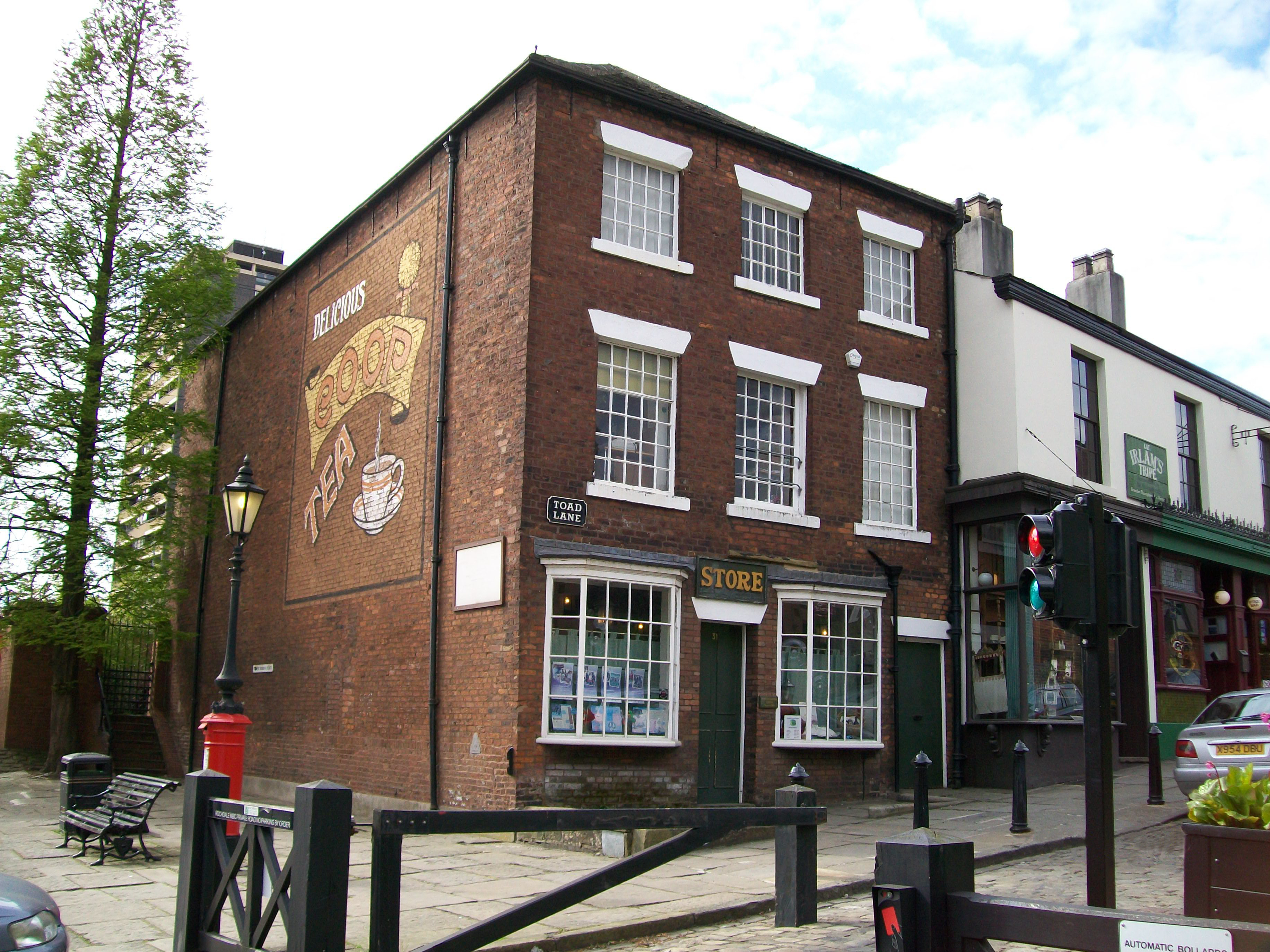|
Royal Arsenal Co-operative Society
The Royal Arsenal Co-operative Society (RACS) was a large consumer co-operative based in south east London, England. The co-operative took its name from the Royal Arsenal munitions works in Woolwich and its motto was: "Each for all and all for each". In 1985 it merged into the national Co-operative Wholesale Society. Establishment and growth Co-operative trading had been rooted in Woolwich and the Royal Arsenal since the mid 18th century. In 1868 the Royal Arsenal Supply Association was established by William Rose (1843–1909?) and Alexander McLeod (1832–1902), consisting of 20 workers from the Royal Arsenal. The first base and store was at Rose's house at 11 Eleanor Road (now Barnard Close). In 1869 Rose was laid off at the Arsenal and emigrated to Canada (where his son William Oliver Rose became a well-known politician). McLeod took over as secretary and moved the store to Parry Place (Spray Street Quarter). The society adopted the Rochdale Principles of profit-sharing an ... [...More Info...] [...Related Items...] OR: [Wikipedia] [Google] [Baidu] |
Powis Street
Powis Street is a partly pedestrianised shopping street in Woolwich in the Royal Borough of Greenwich, south east London, England. It was laid out in the late 18th century and was named after the Powis brothers, who developed most of the land in this part of the town. The street has been rebuilt several times but has retained some notable examples of late-Victorian and Art Deco architecture. Since 2019 the street is part of a conservation area. Location Powis Street is situated in central Woolwich, to the south of, and more or less parallel to the main thoroughfare, the A206 dual carriageway, locally known as Woolwich High Street and Beresford Street. The western end of the street meets the South Circular Road (A205) at Parson's Hill. At its eastern end are the town's two main squares, Beresford Square and General Gordon Square. This is also where Woolwich Arsenal railway and DLR stations are situated and where the future Crossrail station is being built. Since the pedestr ... [...More Info...] [...Related Items...] OR: [Wikipedia] [Google] [Baidu] |
Rochdale Principles
The Rochdale Principles are a set of ideals for the operation of cooperatives. They were first set out in 1844 by the Rochdale Society of Equitable Pioneers in Rochdale, England and have formed the basis for the principles on which co-operatives around the world continue to operate. The implications of the Rochdale Principles are a focus of study in co-operative economics. The original Rochdale Principles were officially adopted by the International Co-operative Alliance (ICA) in 1937 as the Rochdale Principles of Co-operation. Updated versions of the principles were adopted by the ICA in 1966 as the Co-operative Principles and in 1995 as part of the Statement on the Co-operative Identity.ICA Co-operative Principles , 1937, 1966, and 1995 revisions. Current ICA version of co-operative principl ...
|
Woodcraft Folk
Woodcraft Folk is a UK-based educational Youth organisations in the United Kingdom, movement for children and young people. Founded in 1925 and grown by volunteers, it has been a registered charity since 1965 Registered Charity since 2013. and a registered company limited by guarantee since 2012. The constitutional object of this youth organisation is "to educate and empower young people to be able to participate actively in society, improving their lives and others' through active citizenship." History The name 'Woodcraft' was used by writer and naturalist Ernest Thompson Seton at the start of the 20th century when setting up the American proto-Scouting organisation Woodcraft Indians, and in this context meant the skill of living in the open air, close to nature. Seton later influenced Robert Baden-Powell, 1st Baron Baden-Powell, Robert Baden-Powell and became chief scout of the US. John Hargrave admired Seton's work and aimed to revert to it and away from Baden-Powell's influe ... [...More Info...] [...Related Items...] OR: [Wikipedia] [Google] [Baidu] |
Isle Of Wight
The Isle of Wight ( ) is a county in the English Channel, off the coast of Hampshire, from which it is separated by the Solent. It is the largest and second-most populous island of England. Referred to as 'The Island' by residents, the Isle of Wight has resorts that have been popular holiday destinations since Victorian times. It is known for its mild climate, coastal scenery, and verdant landscape of fields, downland and chines. The island is historically part of Hampshire, and is designated a UNESCO Biosphere Reserve. The island has been home to the poets Algernon Charles Swinburne and Alfred, Lord Tennyson. Queen Victoria built her summer residence and final home, Osborne House at East Cowes, on the Isle. It has a maritime and industrial tradition of boat-building, sail-making, the manufacture of flying boats, hovercraft, and Britain's space rockets. The island hosts annual music festivals, including the Isle of Wight Festival, which in 1970 was the largest rock music ... [...More Info...] [...Related Items...] OR: [Wikipedia] [Google] [Baidu] |
Dividend
A dividend is a distribution of profits by a corporation to its shareholders. When a corporation earns a profit or surplus, it is able to pay a portion of the profit as a dividend to shareholders. Any amount not distributed is taken to be re-invested in the business (called retained earnings). The current year profit as well as the retained earnings of previous years are available for distribution; a corporation is usually prohibited from paying a dividend out of its capital. Distribution to shareholders may be in cash (usually a deposit into a bank account) or, if the corporation has a dividend reinvestment plan, the amount can be paid by the issue of further shares or by share repurchase. In some cases, the distribution may be of assets. The dividend received by a shareholder is income of the shareholder and may be subject to income tax (see dividend tax). The tax treatment of this income varies considerably between jurisdictions. The corporation does not receive a tax deduct ... [...More Info...] [...Related Items...] OR: [Wikipedia] [Google] [Baidu] |
Herbert Morrison
Herbert Stanley Morrison, Baron Morrison of Lambeth, (3 January 1888 – 6 March 1965) was a British politician who held a variety of senior positions in the UK Cabinet as member of the Labour Party. During the inter-war period, he was Minister of Transport during the Second MacDonald ministry, then after losing his parliamentary seat in the 1931 United Kingdom general election, he became Leader of the London County Council in the 1930s. After returning to the Commons, he was defeated by Clement Attlee in the 1935 Labour Party leadership election but later acted as Home Secretary in the wartime coalition. Morrison organised Labour's victorious 1945 election campaign, and was appointed Leader of the House of Commons and acted as Attlee's deputy in the Attlee ministry of 1945–51. Attlee, Morrison, Ernest Bevin, Stafford Cripps, and initially Hugh Dalton formed the "Big Five" who dominated those governments. Morrison oversaw Labour's nationalisation programme, although he op ... [...More Info...] [...Related Items...] OR: [Wikipedia] [Google] [Baidu] |
History Of The Cooperative Movement
The history of the cooperative movement concerns the origins and history of cooperatives across the world. Although cooperative arrangements, such as mutual insurance, and principles of cooperation existed long before, the cooperative movement began with the application of cooperative principles to business organization. Beginnings The cooperative movement began in Europe in the 19th century, primarily in Britain and France. The industrial revolution and the increasing mechanisation of the economy transformed society and threatened the livelihoods of many workers. The concurrent labour and social movements and the issues they attempted to address describe the climate at the time. The first documented consumer cooperative was founded in 1769, in a barely furnished cottage in Fenwick, East Ayrshire, when local weavers manhandled a sack of oatmeal into John Walker's whitewashed front room and began selling the contents at a discount, forming the Fenwick Weavers' Society. In 1810, ... [...More Info...] [...Related Items...] OR: [Wikipedia] [Google] [Baidu] |
Eltham
Eltham ( ) is a district of southeast London, England, within the Royal Borough of Greenwich. It is east-southeast of Charing Cross, and is identified in the London Plan as one of 35 major centres in Greater London. The three wards of Eltham North, South and West have a total population of 35,459. 88,000 people live in Eltham. History Origins Eltham developed along part of the road from London to Maidstone, and lies almost due south of Woolwich. Mottingham, to the south, became part of the parish on the abolition of all extra-parochial areas, which were rare anomalies in the parish system. Eltham College and other parts of Mottingham were therefore not considered within Eltham's boundaries even before the 1860s. From the sixth century Eltham was in the ancient Lathe of Sutton at Hone. In the Domesday Book of 1086 its hundred was named ''Gren[u/v]iz'' (Greenwich), which by 1166 was renamed ''Blachehedfeld'' Blackheath, Kent (hundred), (Blackheath) because it had become t ... [...More Info...] [...Related Items...] OR: [Wikipedia] [Google] [Baidu] |
Abbey Wood
Abbey Wood is an area in south east London, England, straddling the border between the Royal Borough of Greenwich and the London Borough of Bexley. It is located east of Charing Cross. Toponymy The area takes its name from Lesnes Abbey Woods, located to the east, which once belonged to the monks of Lesnes Abbey. Development The Abbey of St Mary and St Thomas the Martyr at Lesnes (or Lesnes Abbey) was founded in 1178 by Richard de Luci, Chief Justiciar of England. The Abbot of Lesnes Abbey was an important local landlord, and took a leading part in draining the marshland. However, this and the cost of maintaining river embankments was one of the reasons given for the Abbey's chronic financial difficulties. It never became a large community, and was closed by Cardinal Wolsey in 1525, under a licence to suppress monasteries of less than seven inmates. It was one of the first monasteries to be closed after the Dissolution of the Monasteries in 1524, and the monastic buildings ... [...More Info...] [...Related Items...] OR: [Wikipedia] [Google] [Baidu] |
Charles Booth (social Reformer)
Charles James Booth (30 March 1840 – 23 November 1916) was a British shipowner, social researcher, Comtean positivist, and reformer, best known for his innovative philanthropic studies on working-class life in London towards the end of the 19th century. During the 1860s Booth became interested in the philosophy of Auguste Comte, the founder of modern sociology, and converted to his Religion of Humanity, affiliated with members of the London Positivist Society, and wrote positivist prayers. He was captivated by Comte's idea that in the future, scientific industrialists would be in control of the social leadership instead of the church ministers. Booth's work, along with that of Benjamin Seebohm Rowntree, influenced government policy regarding poverty in the early 20th century and helped initiate Old Age pensions and free school meals for the poorest children. In addition, his investigation would also demonstrate how poverty was influenced by religion, education, and ad ... [...More Info...] [...Related Items...] OR: [Wikipedia] [Google] [Baidu] |






